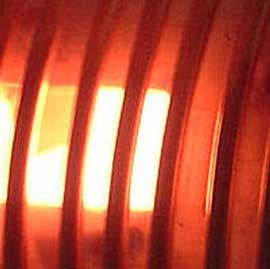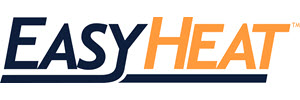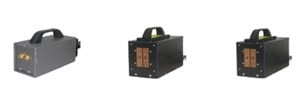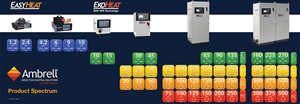Induction Susceptor Heating
- Home
- How It's Used
- Susceptor Heating
What is Susceptor Heating?
A susceptor is induction heated, conducting energy to the work material. Susceptors are made from silicon carbide, molybdenum, graphite, stainless steels and other conductive materials.
Induction generates an electromagnetic field in a work coil that induces currents in the conductive material of a workpiece placed within or near the coil. Friction from these currents elevates the temperature of the susceptor.
Induction susceptor heating Benefits
-
Meets tight production tolerances with precise localized heat to small areas creating pinpoint accuracy
-
Increases production rates with faster heating cycles
-
Reduces defect rates with repeatable, reliable heat
-
Eliminates variability from operator-to-operator, shift-to-shift
-
Maintains metallurgical characteristics of the individual metals

Select an option below:
susceptor heating Application Notes
Select from our collection of susceptor heating notes, developed over 39 years supporting our customers. Read how we helped to solve their process heating challenges!
 Heating a Steel Susceptor for Glass Cutting
Heating a Steel Susceptor for Glass Cutting
A custom-designed single position multiple-turn helical coil was built to generate the required heating for the application. Initial tests were conducted to optimize the power delivered to the part.
 Brazing a steel and copper strip to carbide
Brazing a steel and copper strip to carbide
Induction heating of the steel took less than 30 seconds, is highly repeatable and there is no open flame, clear benefits over flame heating. it a safer method of heating than torch heating
A C-shaped steel susceptor is used to ensure even heating and for ease of loading and unloading the samples.
 Heating a 4-tube carbon susceptor
Heating a 4-tube carbon susceptor
A tubular carbon susceptor is held within an atmosphere controlled quartz chamber. Induction is used to heat the susceptor
 Heating susceptor for glass reflow (X-ray tubes)
Heating susceptor for glass reflow (X-ray tubes)
A two turn helical coil is used for heating. Six graphite susceptors are placed in the nitrogen atmosphere with glass discs and a stainless steel holder.
 Heating aluminium susceptor for powder expansion
Heating aluminium susceptor for powder expansion
Expand powder into solid form for use in crash helmets
 Melting Glass for Fiber Drawing
Melting Glass for Fiber Drawing
To heat a metal susceptor vessel to 2200 °F within 25 minutes with induction for a fiberglass melting application
 Soldering Co-axial Wire to a Metal Frame
Soldering Co-axial Wire to a Metal Frame
Given the small size of the part and the assembly's geometry, a graphite cylinder was required as a susceptor.
susceptor heating Application Notes
Thank you Friend for trusting us with your susceptor heating inquiries. Read any of our application notes below without registration.
 Soldering Co-axial Wire to a Metal Frame
Soldering Co-axial Wire to a Metal Frame
Given the small size of the part and the assembly's geometry, a graphite cylinder was required as a susceptor.
A C-shaped steel susceptor is used to ensure even heating and for ease of loading and unloading the samples.
 Heating a 4-tube carbon susceptor
Heating a 4-tube carbon susceptor
A tubular carbon susceptor is held within an atmosphere controlled quartz chamber. Induction is used to heat the susceptor
 Heating susceptor for glass reflow (X-ray tubes)
Heating susceptor for glass reflow (X-ray tubes)
A two turn helical coil is used for heating. Six graphite susceptors are placed in the nitrogen atmosphere with glass discs and a stainless steel holder.
 Heating aluminium susceptor for powder expansion
Heating aluminium susceptor for powder expansion
Expand powder into solid form for use in crash helmets
 Heating a Steel Susceptor for Glass Cutting
Heating a Steel Susceptor for Glass Cutting
A custom-designed single position multiple-turn helical coil was built to generate the required heating for the application. Initial tests were conducted to optimize the power delivered to the part.
 Melting Glass for Fiber Drawing
Melting Glass for Fiber Drawing
To heat a metal susceptor vessel to 2200 °F within 25 minutes with induction for a fiberglass melting application
 Brazing a steel and copper strip to carbide
Brazing a steel and copper strip to carbide
Induction heating of the steel took less than 30 seconds, is highly repeatable and there is no open flame, clear benefits over flame heating. it a safer method of heating than torch heating
Our Systems for susceptor heating with Induction
AMBRELL CORPORATION
1655 Lyell Avenue
Rochester, NY 14606
United States
![]() Directions
Directions
T: +1 585 889 9000
F: +1 585 889 4030
Contact Sales
Contact Orders
Contact Service
AMBRELL B.V.
Holtersweg 1
7556 BS Hengelo
The Netherlands
![]() Directions
Directions
T: +31 880 150 100
F: +31 546 788 154
Contact Sales
Contact Orders
Contact Service
AMBRELL Ltd.
148-149 Gt Charles Street
Birmingham, GL51 9FL
United Kingdom
T: +44 1242 514042
F: +31 546 788 154
Contact Sales
Contact Orders
Contact Service


 Brazing a heat-sensing probe
Brazing a heat-sensing probe Brazing a heat-sensing probe
Brazing a heat-sensing probe


